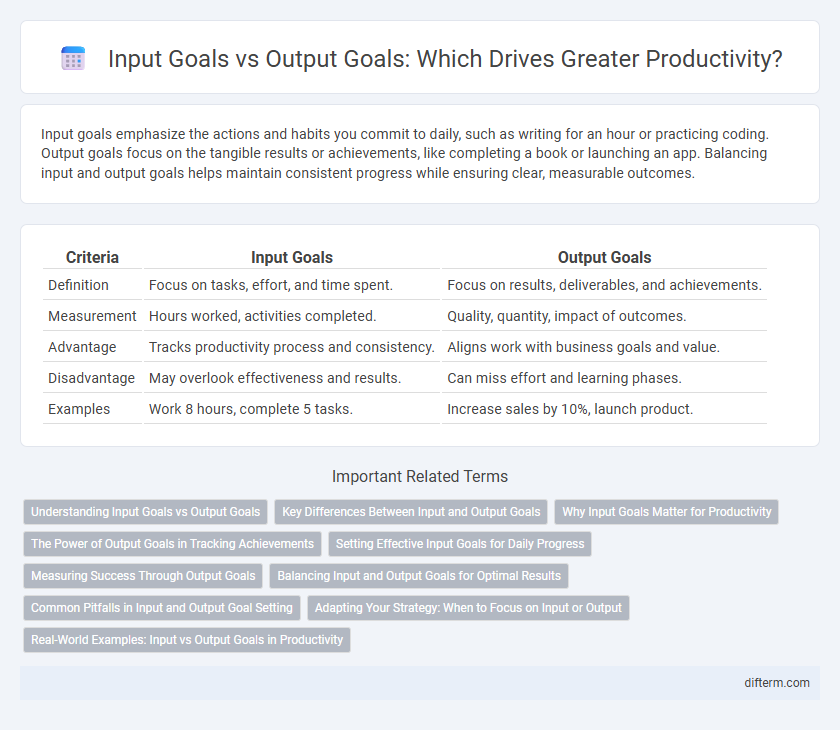Input goals emphasize the actions and habits you commit to daily, such as writing for an hour or practicing coding. Output goals focus on the tangible results or achievements, like completing a book or launching an app. Balancing input and output goals helps maintain consistent progress while ensuring clear, measurable outcomes.
Table of Comparison
| Criteria | Input Goals | Output Goals |
|---|---|---|
| Definition | Focus on tasks, effort, and time spent. | Focus on results, deliverables, and achievements. |
| Measurement | Hours worked, activities completed. | Quality, quantity, impact of outcomes. |
| Advantage | Tracks productivity process and consistency. | Aligns work with business goals and value. |
| Disadvantage | May overlook effectiveness and results. | Can miss effort and learning phases. |
| Examples | Work 8 hours, complete 5 tasks. | Increase sales by 10%, launch product. |
Understanding Input Goals vs Output Goals
Input goals emphasize the specific actions and habits necessary to achieve desired results, such as dedicating hours to focused work or following a consistent routine. Output goals prioritize the measurable outcomes or deliverables, like completing a project or reaching a sales target. Understanding the distinction between input and output goals enables better planning and sustained productivity by balancing effort with tangible results.
Key Differences Between Input and Output Goals
Input goals emphasize the specific actions and processes required to achieve desired outcomes, focusing on effort and habits such as hours worked or tasks completed. Output goals prioritize measurable results and tangible achievements like sales numbers, project completions, or performance metrics. Understanding these distinctions helps individuals and teams optimize productivity by aligning daily activities (input) with strategic objectives (output).
Why Input Goals Matter for Productivity
Input goals matter for productivity because they concentrate on actionable steps that individuals can control daily, such as hours spent working or tasks completed. Unlike output goals, which focus on final results and can be influenced by external factors, input goals enable consistent progress and foster sustainable habits. Focusing on input goals reduces overwhelm and provides clear metrics for improvement, ultimately driving more reliable productivity gains.
The Power of Output Goals in Tracking Achievements
Output goals emphasize measurable results and tangible achievements, providing clear indicators of progress and success. Tracking output goals fosters motivation by showcasing concrete outcomes rather than just effort, enabling more effective adjustments in strategies. This focus enhances productivity by aligning daily actions with desired end results, ensuring that efforts translate directly into accomplishments.
Setting Effective Input Goals for Daily Progress
Setting effective input goals for daily progress involves defining specific, actionable tasks that directly influence desired outcomes, ensuring consistent effort and measurable improvement. Input goals prioritize activities such as time spent on skill development, task completion rates, or engagement levels, which drive productivity regardless of immediate results. Focusing on input goals fosters sustainable habits and process-oriented workflows that ultimately enhance overall performance and achievement.
Measuring Success Through Output Goals
Measuring success through output goals provides a clear and objective assessment of productivity by focusing on tangible results rather than mere effort or hours invested. Output goals, such as completed projects, sales numbers, or client satisfaction scores, directly reflect the impact and effectiveness of work performed. Prioritizing output over input encourages goal-oriented actions and drives consistent achievement aligned with organizational objectives.
Balancing Input and Output Goals for Optimal Results
Balancing input goals, such as time spent and resources allocated, with output goals like measurable achievements ensures optimal productivity by aligning effort with results. Monitoring key performance indicators (KPIs) linked to both input and output metrics allows for continuous adjustment and improved efficiency. This equilibrium helps maintain motivation and drives sustainable success in any productivity-focused endeavor.
Common Pitfalls in Input and Output Goal Setting
Input goals often suffer from vagueness and lack of measurable criteria, leading to inconsistent effort and reduced accountability. Output goals may be overly ambitious or insufficiently specific, causing frustration and decreased motivation when results are not achieved. Balancing clear, actionable input goals with realistic, outcome-driven output goals is essential to avoid these common pitfalls in productivity management.
Adapting Your Strategy: When to Focus on Input or Output
Input goals emphasize consistent effort and daily habits that drive progress, while output goals measure tangible results and achievements. Adapting your strategy involves shifting focus to input goals during learning or skill-building phases and prioritizing output goals when evaluating performance or completing projects. Balancing these approaches ensures sustained productivity and continuous improvement.
Real-World Examples: Input vs Output Goals in Productivity
Input goals, such as dedicating two hours daily to focused work sessions, emphasize consistent effort and process improvement, leading to sustainable productivity increases. Output goals focus on measurable results, like completing five project tasks per week, driving clear performance targets but sometimes overlooking workflow quality. For example, a sales representative may set an input goal of making 30 calls daily, while the output goal targets 10 closed deals per month, balancing effort with tangible outcomes.
Input goals vs Output goals Infographic

 difterm.com
difterm.com